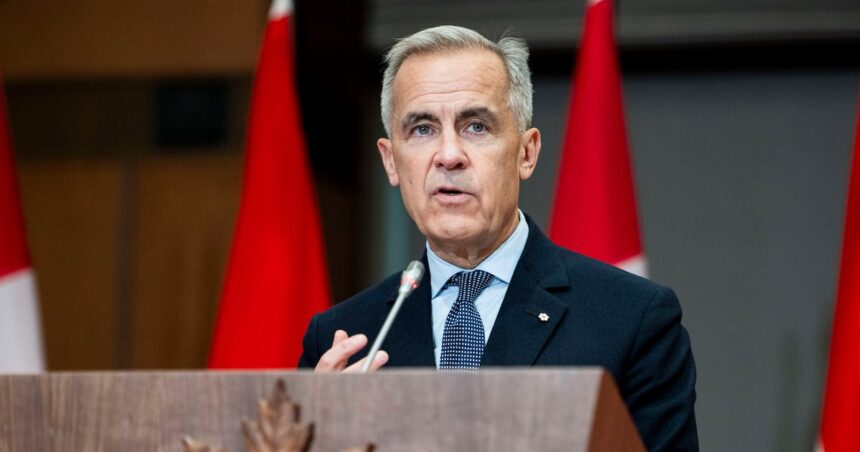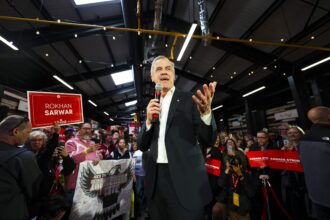In the dimly lit corridors of power in Ottawa, Prime Minister Mark Carney paces thoughtfully, six months into a premiership already defined by unprecedented global trade hostilities. What began as diplomatic friction has evolved into a full-blown economic siege, with Canada caught in a precarious position between its largest trading partners—the United States and China—who are themselves locked in an intensifying economic rivalry.
“We find ourselves at a historic crossroads,” Carney remarked during yesterday’s emergency economic briefing. “Canada’s prosperity has always been built on open trade, but today we face protectionist pressures from all sides with diminishing leverage to navigate these treacherous waters.”
The former Bank of England governor, once celebrated for his financial acumen, now confronts a dual-front trade conflict that threatens to undermine Canada’s economic recovery. Statistics released by Finance Canada reveal a troubling trend: exports to the United States have declined by 17% since January, while Chinese tariffs on Canadian agricultural products have slashed farm revenues by nearly $3.4 billion in just two quarters.
Industry leaders across the country express mounting concern. “This isn’t just about quarterly profits anymore,” warns Sophia Cheng, CEO of the Canadian Manufacturing Coalition. “We’re talking about fundamental restructuring of supply chains that took decades to build. Some of these changes may become permanent if solutions aren’t found quickly.”
The American front presents particular challenges. President Eleanor Hughes’ administration has doubled down on “Buy American” provisions that effectively exclude Canadian companies from infrastructure projects. The controversial “North American Resilience Act” passed in July imposes strict domestic content requirements that have left Canadian auto parts manufacturers and technology firms scrambling to adapt.
“The irony is painful,” notes Dr. Michael Thornton, senior economist at the Royal Bank of Canada. “Carney was recruited into politics precisely because of his international economic credentials, yet he finds himself with fewer cards to play than any Prime Minister in recent memory. The traditional Canadian approach of quiet diplomacy appears increasingly ineffective in this new era of economic nationalism.”
Meanwhile, in the Asia-Pacific theater, Chinese authorities have systematically targeted Canadian exports in what analysts describe as retaliation for Canada’s alignment with American technology restrictions. Beijing’s suspension of canola imports alone costs Prairie farmers approximately $220 million monthly, according to Agriculture Canada.
Carney’s cabinet has responded with a two-track strategy that shows limited results thus far. Domestically, the government has introduced a $7 billion “Economic Resilience Fund” to support affected industries. Internationally, Canada has intensified efforts to diversify trade relationships, with Trade Minister Anita Anand completing whirlwind diplomatic tours through Southeast Asia, Europe, and Latin America.
“We’re pursuing every available avenue,” Anand stated from Brussels last week. “The comprehensive economic partnership agreement with Indonesia represents just one example of our commitment to finding new markets for Canadian goods and services.”
Critics, however, question whether these efforts can offset the massive impact of disrupted relations with Canada’s dominant trading partners. Opposition Leader Pierre Poilievre has seized on the issue, claiming that “Carney’s financial wizardry has proven remarkably ineffective when confronted with real-world political challenges.”
The challenges extend beyond immediate economic impacts. Investment in Canadian manufacturing has dropped precipitously, with foreign direct investment declining 28% year-over-year. Major multinationals increasingly view Canada as caught in geopolitical crossfire, leading to delayed or canceled expansion plans.
Corporate anxiety is palpable across the Canadian business landscape. “We’re essentially being forced to choose sides in a conflict where either choice carries substantial penalties,” explains Jean Bouchard, President of the Quebec Business Council. “Companies are postponing major decisions while trying to determine whether these trade restrictions represent the new normal or a temporary disruption.”
For ordinary Canadians, the consequences manifest in subtle but meaningful ways. Consumer prices for imported goods have risen 5.4% since January, with particularly sharp increases in electronics, appliances, and pharmaceuticals. Employment in export-dependent regions shows troubling trends, with Windsor-Essex County reporting manufacturing job losses approaching 3,800 positions since March.
Carney’s response to these challenges will likely define his political legacy. Known for intellectual precision rather than emotional appeal, the Prime Minister faces the additional challenge of communicating complex economic realities to a public increasingly frustrated by rising costs and economic uncertainty.
“The fundamental question facing Canada isn’t whether we’ll experience pain from these trade conflicts—that’s already occurring,” observes Dr. Elena Rodriguez, Director of the Centre for International Trade at the University of Toronto. “The real question is whether we can transform this crisis into an opportunity for economic reinvention, or if we’ll simply absorb punishment while waiting for geopolitical winds to shift.”
As autumn settles over Ottawa and Carney prepares for crucial meetings at both the G20 and APEC summits, Canadians watch closely to see if the celebrated economic mind can translate theoretical expertise into practical solutions for a nation caught between competing economic superpowers. In this high-stakes diplomatic chess match, can Canada find a path that preserves its economic sovereignty while navigating the treacherous waters of 21st century trade politics?










